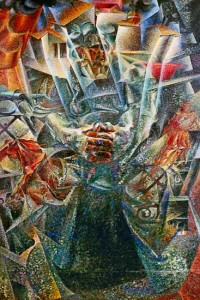MASTERPIECES OF FUTURISM AT THE PEGGY GUGGENHEIM COLLECTION
February 18 – December 31, 2009
Curated by Philip Rylands
PRESS RELEASE (courtesy of the PGC)
A RARE OPPORTUNITY TO SEE GREAT WORKS BY THE MASTERS OF ITALIAN FUTURISM.
One hundred years after the publication in Le Figaro on February 20 1909 of the Futurist Manifesto, signed by the ‘jeune poète italien’ Filippo Tommaso Marinetti, the Peggy Guggenheim Collection celebrates this revolutionary avant-garde movement with the exhibition Masterpieces of Futurism at the Peggy Guggenheim Collection, curated by Philip Rylands, director of the Venetian museum (from February 18 through 2009). The exhibition also serves as an homage to the foresight of Gianni Mattioli, one of the great collectors of 20th century art, who accumulated a comprehensive presence of Futurism in his collection. This includes works by Giacomo Balla, Umberto Boccioni, Carlo Carrà, Luigi Russolo, Gino Severini, Ottone Rosai, Mario Sironi and Ardengo Soffici.
Masterpieces of Futurism at the Peggy Guggenheim Collection presents key paintings of the movement such as Materia and Dynamism of a Cyclist by Boccioni, Mercury Passing Before the Sun by Balla, The Galleria of Milan by Carrà, Blue Dancer by Severini, three works from Peggy Guggenheim’s collection (Severini’s Sea = Dancer, Balla’s Abstract Speed + Sound, and Boccioni’s sculpture Dynamism of a Speeding Horse + Houses), as well as loans from private collections by Balla, Boccioni, Carrà and Sironi. This will also be the debut of a recent gift to the Solomon R. Guggenheim Foundation, Sironi’s early masterpiece The Cyclist (1916). The exhibition includes three of Boccioni’s four extant sculptures: in addition to the mixed media Dynamism of a Speeding Horse + Houses, bronze cast of his celebrated Development of a Bottle in Space and Unique Forms of Continuity in Space.
An introductory section of paintings, sculptures and drawings contextualizes the Futurist movementwith works of other historical avant-gardes, such as Divisionism, Cubism, Orphism and Vorticism. Jean Metzinger and Raymond Duchamp-Villon explored notions of movement and the mechanical dynamism of modern life, while the London Vorticist Edward Wadsworth, who was inspired by the rhetoric of Marinetti, is represented with two woodcuts, Street Singers and Top of the Town, each of them recent gifts to the Solomon R. Guggenheim Foundation, and now on exhibition for the first time.
Marinetti’s incendiary manifesto of 1909, which concluded “From the summit of the world we hurl once more our insolent challenge to the stars,” was literary in its focus (“the essential elements of our poetry shall be courage, daring and rebellion”), but it made a general appeal for the sweeping renewal of all aspects of Italian culture, predicated on dynamism, speed and technology. A year later five artists signed manifestoes of Futurist painting, on February 11 and April 11, 1910. They were Balla, Boccioni, Carrà, Russolo, and Severini, all of them represented with masterpieces in the Mattioli collection, which has been hosted by the Peggy Guggenheim Collection since 1997 on long-term loan. Flavio Fergonzi’s major work of scholarship, The Gianni Mattioli Collection, published in 2003 by Skira, documents the treasures of this special collection of 20th century art in a broad and comprehensive way.
*As a long-time fan of the Mattioli and Peggy Guggenheim Collections, I highly recommend seeing these works if you have not visited the collection before! My guess is that recently donated works, such as The Cyclist, by Sironi came from the collection of Margherita Sarfatti.
